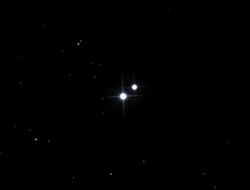Astronomy:Zeta2 Lyrae
| Observation data Equinox J2000.0]] (ICRS) | |
|---|---|
| Constellation | Lyra |
| Right ascension | 18h 44m 48.19919s[1] |
| Declination | +37° 35′ 40.5585″[1] |
| Apparent magnitude (V) | 5.74[2] |
| Characteristics | |
| Spectral type | F0 IVn[3] or F1Vnn[4] |
| U−B color index | +0.06[2] |
| B−V color index | +0.29[2] |
| Astrometry | |
| Radial velocity (Rv) | −25.0±3.7[5] km/s |
| Proper motion (μ) | RA: +23.969[1] mas/yr Dec.: +23.461[1] mas/yr |
| Parallax (π) | 20.6386 ± 0.0443[1] mas |
| Distance | 158.0 ± 0.3 ly (48.5 ± 0.1 pc) |
| Absolute magnitude (MV) | +2.34[6] |
| Details | |
| Mass | 1.74[7] M☉ |
| Radius | 2.03±0.02[1] R☉ |
| Luminosity | 9.5±0.1[1] L☉ |
| Surface gravity (log g) | 3.94[7] cgs |
| Temperature | 7,257+37 −3[1] K |
| Metallicity [Fe/H] | −0.36[1] dex |
| Rotational velocity (v sin i) | 212[8] km/s |
| Age | 1.223[7] Gyr |
| Other designations | |
| Database references | |
| SIMBAD | data |

Zeta2 Lyrae is a single,[10] white-hued star in the northern constellation of Lyra. It is a dim star that is just visible to the naked eye with an apparent visual magnitude of 5.74[2] An annual parallax shift of 20.6 mas as seen from Earth provides a distance estimate of about 158 light years from the Sun. It is moving closer to the Sun with a radial velocity of −25 km/s.[5]
This star has a stellar classification of F0 IVn,[3] suggesting it is an F-type subgiant star that is evolving away from the main sequence as its supply of hydrogen at the core has been consumed. The n suffix indicates "nebulous" lines caused by its rotation. It is spinning rapidly with a projected rotational velocity of 212 km/s.[8] This is giving the star an oblate shape with an equatorial bulge that is an estimated 29% larger than the polar radius.[11] The star is radiating approximately 9.6 times the Sun's luminosity from the photosphere at an effective temperature of about 7,000 K.[1] It has 1.7[7] times the mass of the Sun, twice the Sun's radius,[1] and is about 1.2[7] billion years old.
It is a suspected variable.[9]
References
- ↑ 1.00 1.01 1.02 1.03 1.04 1.05 1.06 1.07 1.08 1.09 1.10 Vallenari, A. et al. (2022). "Gaia Data Release 3. Summary of the content and survey properties". Astronomy & Astrophysics. doi:10.1051/0004-6361/202243940 Gaia DR3 record for this source at VizieR.
- ↑ 2.0 2.1 2.2 2.3 Deutschman, W. A. et al. (February 1976), "The galactic distribution of interstellar absorption as determined from the Celescope catalog of ultraviolet stellar observations and a new catalogue of UBV, Hbeta photoelectric observations", Astrophysical Journal Supplement Series 30: 97–225, doi:10.1086/190359, Bibcode: 1976ApJS...30...97D.
- ↑ 3.0 3.1 Cowley, A. et al. (April 1969), "A study of the bright A stars. I. A catalogue of spectral classifications", Astronomical Journal 74: 375–406, doi:10.1086/110819, Bibcode: 1969AJ.....74..375C
- ↑ Gray, R. O.; Napier, M. G.; Winkler, L. I. (2001), "The Physical Basis of Luminosity Classification in the Late A-, F-, and Early G-Type Stars. I. Precise Spectral Types for 372 Stars", The Astronomical Journal 121 (4): 2148, doi:10.1086/319956, Bibcode: 2001AJ....121.2148G.
- ↑ 5.0 5.1 Kharchenko, N. V. et al. (2007), "Astrophysical supplements to the ASCC-2.5: Ia. Radial velocities of ˜55000 stars and mean radial velocities of 516 Galactic open clusters and associations", Astronomische Nachrichten 328 (9): 889–896, doi:10.1002/asna.200710776, Bibcode: 2007AN....328..889K.
- ↑ Anderson, E.; Francis, Ch. (2012), "XHIP: An extended hipparcos compilation", Astronomy Letters 38 (5): 331, doi:10.1134/S1063773712050015, Bibcode: 2012AstL...38..331A.
- ↑ 7.0 7.1 7.2 7.3 7.4 David, Trevor J.; Hillenbrand, Lynne A. (2015). "The Ages of Early-Type Stars: Strömgren Photometric Methods Calibrated, Validated, Tested, and Applied to Hosts and Prospective Hosts of Directly Imaged Exoplanets". The Astrophysical Journal 804 (2): 146. doi:10.1088/0004-637X/804/2/146. Bibcode: 2015ApJ...804..146D. Vizier catalog entry
- ↑ 8.0 8.1 Royer, F.; Zorec, J.; Gómez, A. E. (February 2007), "Rotational velocities of A-type stars. III. Velocity distributions", Astronomy and Astrophysics 463 (2): 671–682, doi:10.1051/0004-6361:20065224, Bibcode: 2007A&A...463..671R.
- ↑ 9.0 9.1 "zet02 Lyr". SIMBAD. Centre de données astronomiques de Strasbourg. http://simbad.u-strasbg.fr/simbad/sim-basic?Ident=zet02+Lyr.
- ↑ De Rosa, R. J. et al. (2014). "The VAST Survey - III. The multiplicity of A-type stars within 75 pc". Monthly Notices of the Royal Astronomical Society 437 (2): 1216. doi:10.1093/mnras/stt1932. Bibcode: 2014MNRAS.437.1216D.
- ↑ Belle, G. T. (2012). "Interferometric observations of rapidly rotating stars". The Astronomy and Astrophysics Review 20 (1): 51. doi:10.1007/s00159-012-0051-2. Bibcode: 2012A&ARv..20...51V.
 |

